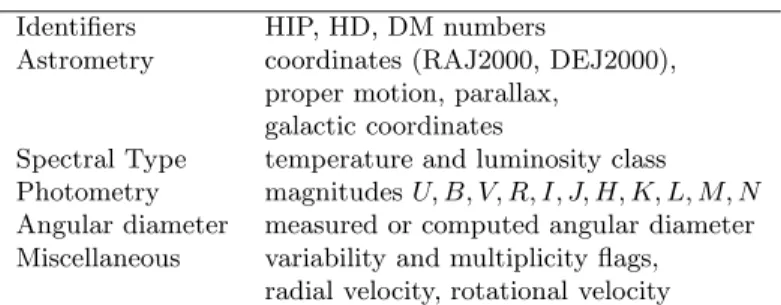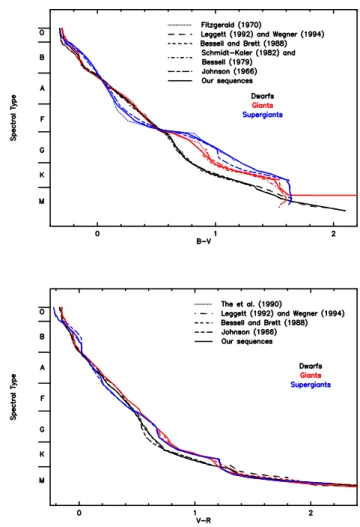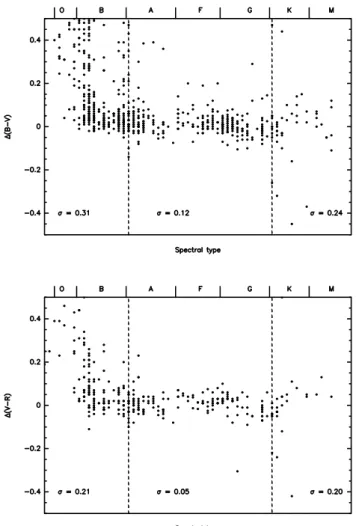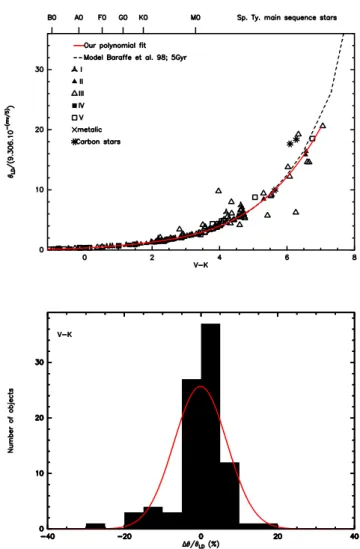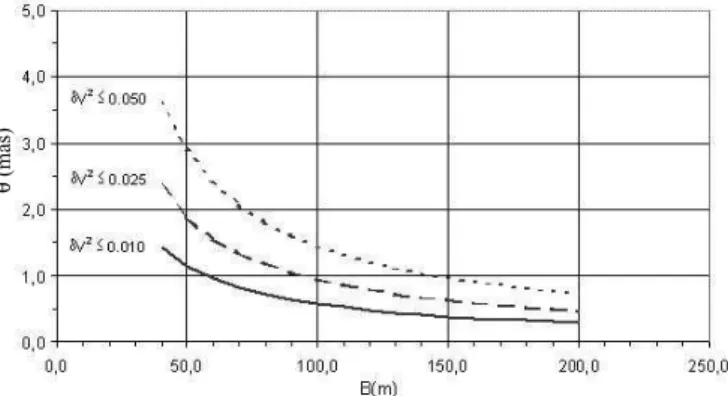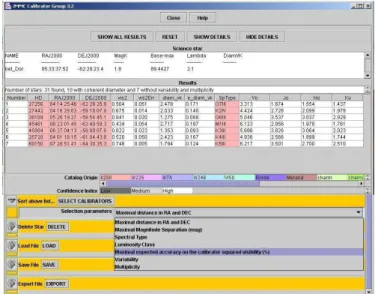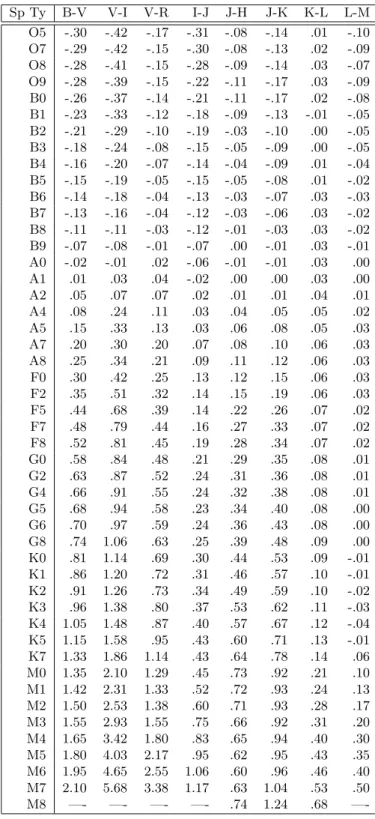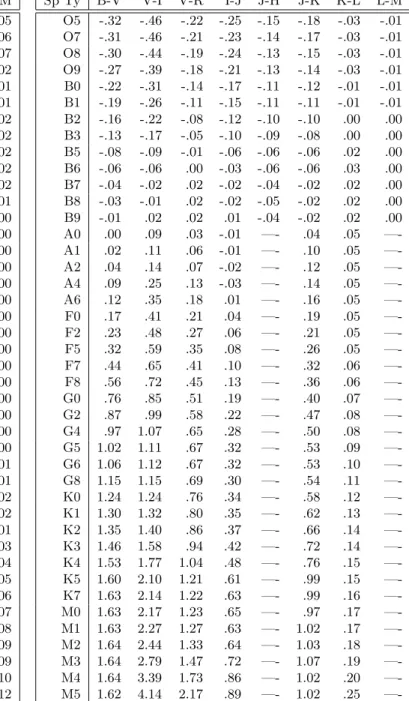HAL Id: hal-00083694
https://hal.archives-ouvertes.fr/hal-00083694
Preprint submitted on 3 Jul 2006
HAL is a multi-disciplinary open access
archive for the deposit and dissemination of
sci-entific research documents, whether they are
pub-lished or not. The documents may come from
teaching and research institutions in France or
abroad, or from public or private research centers.
L’archive ouverte pluridisciplinaire HAL, est
destinée au dépôt et à la diffusion de documents
scientifiques de niveau recherche, publiés ou non,
émanant des établissements d’enseignement et de
recherche français ou étrangers, des laboratoires
publics ou privés.
SearchCal: a Virtual Observatory tool for searching
calibrators in optical long baseline interferometry. I:
The bright object case.
Daniel Bonneau, J.-M. Clausse, X. Delfosse, D. Mourard, S. Cetre, A. Chelli,
P. Cruzalèbes, G. Duvert, G. Zins
To cite this version:
Daniel Bonneau, J.-M. Clausse, X. Delfosse, D. Mourard, S. Cetre, et al.. SearchCal: a Virtual
Observatory tool for searching calibrators in optical long baseline interferometry. I: The bright object
case.. 2006. �hal-00083694�
ccsd-00083694, version 1 - 3 Jul 2006
Astronomy & Astrophysicsmanuscript no. 4469SCal.hyper6580 ESO 2006c July 3, 2006
SearchCal: a Virtual Observatory tool for searching calibrators in
optical long baseline interferometry
I: The bright object case
D. Bonneau
1, J.-M. Clausse
1, X. Delfosse
2, D. Mourard
1, S. Cetre
2, A. Chelli
2, P. Cruzal`ebes
1, G.
Duvert
2, and G. Zins
21
Observatoire de la Cˆote d’Azur, Dpt. Gemini, UMR 6203, F-06130 Grasse, France
2
Laboratoire d’Astrophysique de l’Observatoire de Grenoble, UMR 5571, F-38041 Grenoble, France Received ... ; accepted ...
ABSTRACT
Context. In long baseline interferometry, the raw fringe contrast must be calibrated to obtain the true visibility and then those observables that can be interpreted in terms of astrophysical parameters. The selection of suitable calibration stars is crucial for obtaining the ultimate precision of interferometric instruments like the VLTI. Potential calibrators must have spectro-photometric properties and a sky location close to those of the scientific target.
Aims.We have developed software (SearchCal ) that builds an evolutive catalog of stars suitable as calibrators within any given user-defined angular distance and magnitude around the scientific target. We present the first version of SearchCal dedicated to the bright-object case (V≤10; K≤5).
Methods. Star catalogs available at the CDS are consulted via web requests. They provide all the useful information for selecting of calibrators. Missing photometries are computed with an accuracy of 0.1 mag and the missing angular diameters are calculated with a precision better than 10%. For each star the squared visibility is computed by taking the wavelength and the maximum baseline of the foreseen observation into account.
Results. SearchCal is integrated into ASPRO, the interferometric observing preparation software developed by the JMMC, available at the address: http://mariotti.fr.
Key words. Techniques:high angular resolution – Techniques:interferometric– Stars: fundamentals parameters – Catalogs – Astronomical database: miscellaneous
1. Introduction
A long baseline optical interferometer measures the spatio-temporal coherence (i.e. the visibility) of the target. This measure is directly related to the Fourier transform of the object’s intensity map at the spatial frequencies B
λ, B
being the baseline vector between two telescopes. Optical interferometry provides a powerful tool for determining the morphology of astronomical sources at high angular resolution. The modulus and the phase of the visibility are derived respectively from the contrast and the position of the fringes resulting from the recombination process.
The atmospheric turbulence and instrumental insta-bilities induce long-term and short-term drifts that dis-tort the phase and decrease the amplitude of the target’s visibility Vtarget by a factor Γ called the instrumental
re-sponse. The observed visibility µtarget could then be
writ-ten as
µ2target= V2targetΓ2. (1)
In order to take these effects into account and to con-vert the observed fringe contrast into true visibility, the observation of the scientific target is usually bracketed by observations of calibration stars. In practice, observing a calibration star whose visibility Vcalcan be accurately
de-duced from direct or indirect determination of its angular diameter leads to a determination of Γ:
Γ = |µcal| |Vcal|
. (2)
It is then possible to calculate the accuracy on the target’s visibility: ∆V2 target V2 target ≃ ∆V 2 cal V2 cal +∆µ 2 Γ2 ( 1 V2 cal + 1 V2 target ) (3)
where ∆µ2 ≃ ∆µ2
target ≃ ∆µ2cal is the uncertainty on
the measurement of the visibility amplitudes. Equation 3 shows that the expected accuracy on the target visibility strongly depends on the accuracy of the calibrator visibil-ity.
A calibrator is a star for which the visibility is known (or can be predicted) with high accuracy. It should have physical properties (magnitude, spectral-type, colors) and a sky location close to those of the scientific target, so that the instrumental response during the calibrator-target-calibrator sequence could be considered as independent of the object.
The selection of suitable calibration stars is crucial to obtain the ultimate precision of the interferometric instruments. Until now, each interferometric group has had its own strategy for calibrating the observations ei-ther by using reference stars chosen case by case or using specific tools of selection. In 2002, Bord´e et al. published a catalog of 374 reference stars selected from the initial list of Cohen’s spectro-photometric calibrators (Cohen et al. 1999) using selection criteria adapted to in-frared interferometry up to a 200 m baseline. More re-cently, an observing program (Percheron et al. 2003) was set up to create a list of reference stars with accurate measured angular diameters suitable for calibrating the infrared interferometric observations of the Very Large Telescope Interferometer (VLTI) instruments (VINCI, MIDI, AMBER). To prepare interferometric observations with the Palomar Testbed Interferometer (PTI) and Keck Interferometer (KI), an interferometric observation plan-ning software GetCal has been developed (Boden 2003), including a tool to compute the visibility of potential reference stars taken in the Hipparcos catalog and ex-tracting astronomical and spectro-photometric parame-ters from the Simbad database at the Centre de Donn´ees Astronomiques de Strasbourg (CDS)(Genova et al., 2000). With the startup of long-baseline and large-aperture optical interferometers, such as VLTI, KI, or the CHARA array, and with the increase in the accuracy or in the range in sensitivity and angular resolution, the calibration of interferometric data requires definiting new strategies for seeking suitable calibrators and developing of selection tools usable by a larger community of astronomers.
In Sect. 2, we present our method for creating a dy-namical list of stars fulfilling the requirements of interfer-ometric calibrators for a bright scientific target(K ≤ 5). Section 3 briefly depicts the different scenarii of request to the CDS database, in order to extract the useful parame-ters from stellar catalogs and to sort out the initial list of possible calibration stars. Section 4 deals with the major steps in the calculations (interstellar absorption, angular diameters, visibility) for each star on the list. Some techni-cal aspects are mentioned in Sect. 5. Finally, the current limitations of SearchCal and its evolution to in case of faint targets are discussed in the last section.
2. Our original method
The design of a search calibrator tool available in ASPRO (Duvert et al., 2002, Duchene et al., 2004) was guided by the goal of creating a dynamical catalog of calibration stars suitable for each scientific target. The goal was to provide a list of potential calibration stars for which the visibilities are calculated from their angular diameters and the maximum spatial frequency (B
λ) of the interferometric
observation. The search for calibrators must work as well for long baseline interferometric observations carried out in the visible (V band), the near infrared (J, H, or K bands), or the mid infrared (N band).
The “Virtual Observatory” techniques were adopted to extract the required astronomical information from a set of stellar catalogs available at the CDS. Compared to the static or closed-list approach, the merit of this strategy is first to take into account any enrichment of the catalogs by new observational data and secondly to be much more adapted to the limits in magnitude of the coming inter-ferometric facilities (VLTI with four 8 m or KI with two 10 m telescopes).
To minimize the effects of temporal and spatial varia-tions of the seeing on the calibration process, a calibrator must be as close as possible to the scientific target. The field size on the sky is defined by the maximum differ-ence in right ascension and declination. To be observable with the same instrumental configuration, the magnitude of the calibrator must be in a narrow range of value around the target magnitude in the observing photometric band. In order to select stars as potential calibrators, a certain number of astronomical parameters must be known for each star. These parameters are given in Table 1.
Table 1.Astronomical parameters for calibration stars
Identifiers HIP, HD, DM numbers
Astrometry coordinates (RAJ2000, DEJ2000), proper motion, parallax,
galactic coordinates
Spectral Type temperature and luminosity class Photometry magnitudes U, B, V, R, I, J, H, K, L, M, N Angular diameter measured or computed angular diameter Miscellaneous variability and multiplicity flags,
radial velocity, rotational velocity
An on-line interface with the VizieR data base (Ochsenbein et al., 2000) at the CDS was created to ex-tract astrometric and spectro-photometric parameters of the sources in the defined box and to obtain the initial list of stars (see details in the next section). This list is enriched by the stars present in the Catalogue of calibra-tors for long baseline stellar interferometry (Bord´e et al., 2002) and the Catalog of bright calibrator stars for 200-m baseline near-infrared stellar interfero200-metry (M´erand et al., 2005). If available, the measured angular diame-ter is obtained through the data of the Catalog of High
D. Bonneau et al.: SearchCal : the bright object case 3
Angular Resolution Measurements (Richichi, Percheron and Khristoforova, 2005).
For each star on the initial list, calculations are made to correct the interstellar absorption and to compute miss-ing magnitudes. The photometric angular diameter and its associated accuracy are estimated using a surface bright-ness method based on the (B − V ), (V − R) and (V − K) color index. Then, the expected visibility and its error are computed.
The list of possible calibrators is finally proposed to the user and the final choice can be made by changing the selection criteria: accuracy on the calibrator visibility, size of the field, magnitude range, spectral type and luminosity class, variability and multiplicity flags.
3. The CDS interrogation
To build a dynamical list of stars, we chose to extract the information from catalogs available at the CDS. Different scenarii were implemented depending on the photometric band selected for the interferometric observations, i.e. in the visible (V band) or the near infrared (K band). For each star the astronomical parameters were extracted from the following catalogs:
– I/280: All-sky Compiled Catalog of 2.5 million stars (Kharchenko, 2001)
– II/7A: UBVRIJKLMNH Photoelectric Catalog (Morel et al., 1978)
– II/225: Catalog of Infrared Observations, Edition 5 (Gezari et al., 1999)
– II/246/out: The 2MASS all-sky survey Catalog of Point Sources (Cutri et al., 2003)
– J/A+A/413/1037: catalog J-K DENIS photometry of bright southern stars ((S. Kimeswenger et al.,2004) – I/196/main: Hipparcos Input Catalog, Version 2
(Turon et al., 1993)
– V/50: Bright Star Catalog, 5th Revised Ed. (Hoffleit et al., 1991)
– V/36B: Supplement to the Bright Star Catalog (Hoffleit et al., 1983)
– J/A+A/393/183: Catalog of calibrator stars for LBSI (Bord´e et al., 2002)
– J/A+A/433/1155: Calibrator stars for 200-m baseline interferometry (Merand et al., 2005)
– J/A+A/431/773/charm2: Catalog of High Angular Resolution Measurements (Richichi et al., 2005) To define of the extracted data and the limitation of the number of returns, we used for each catalog the data fields defined by UCDs (Unified Content Descriptors) and labels and the limits on the data’s values. Our strategy is based on two sequences of requests on the VizieR data base.
3.1. Primary request
An on-line interface with the CDS has been created to ob-tain the initial list of stars present in the calibrator field
and with magnitudes according to the specified magnitude range. This request is done on catalog(s) called “primary catalog(s)” depending on the scenario. The primary cata-logs were selected with respect to the quality of the equa-torial coordinates and of the available photometry. In the case of the “visible” scenario, the choice was thus made on the compiled catalog I/280 because of the need to have a reliable value for the magnitude V and precise coordi-nates for stars brighter than typically V mag ≤ 10. For the “near infrared” scenario, it was mandatory to have the K magnitude of a star brighter than typically Kmag ≤ 5, and the choice was made to take the compiled catalogs I/225, II/7A, and II/246 as primary catalogs. The output of this first sequence of requests is a list of star coordi-nates having magnitude values as specified in the defined calibrator field.
3.2. Secondary request
The second sequence of requests is done on the stars con-tained in the previous list and with the goal of extract-ing astrometric and spectro-photometric parameters. The secondary catalogs were selected because of the relevance and the reliability of the parameters of interest for our purpose. In the current version of SearchCal, the identi-fiers, the equatorial coordinates, the proper motions, the parallaxes, spectral type, and variability or multiplicity flags are extracted from the I/280 catalog. For bright stars, the visible photometry comes from I/280, whereas infrared photometry is taken from the II/7A, II/225 and II/246 catalogs. The galactic coordinates are taken from the I/196 or II/246 catalogs. The radial velocity and ro-tational velocity are extracted from the I/196, V/50 or V26B catalogs, respectively.
3.3. Setting the list of possible calibrators
We then parse and merge all the results in a single ar-ray of stars with all the astronomical parameters. The catalogs are first linked according to the HD number if provided and with the equatorial coordinates found in the different catalogs if they are coherent at the level of 1 arc second. The V magnitude (for V band) or the K magni-tude (for infrared bands) is also used to confirm that the star present in the different catalogs is the same. The final result is a single list containing stars for which the suit-able astronomical parameters have been extracted from the selected catalogs.
4. The central engine of the calibrator’s
parameters calculation
For the stars contained in the final list of the CDS re-quests, we need to compute their apparent diameters (ex-cept if they have already been measured) to determine their visibilities in the interferometric configuration. This is done in several stages: first we correct the photometry from interstellar absorption, then we compute the possible
missing photometric data, and finally the apparent diam-eter is obtained from surface brightness relation.
4.1. Interstellar absorption
We must correct the photometric data for the wavelength-dependent effects of the galactic interstellar extinction. In the current version of SearchCal, all the calibrators are bright enough to have a measurement of their trigono-metric parallax. For each star, the visual absorption AV
is computed as a function of the galactic coordinates (longitude l and latitude b) and of the distance d. As all calibration stars currently selected by SearchCal have d ≤ 1000pc, we have used the analytic expression for the interstellar extinction in the solar neighborhood given by Chen et al. (1998).
The observed magnitudes mag[λ] are then corrected for interstellar absorption using:
mag[λ]0= mag[λ] − Aλ (4)
Rλ= Aλ/E(B − V ) (5)
Aλ= AVRλ/RV (6)
with RV = 3.10 and the values of Rλ given by Fitzpatrick
(1999).
4.2. Rebuilding missing photometries
The knowledge of all the BV RIJHK photometry of the calibrator is useful for the interferometric observation. In particular, it could be important to have a calibrator with similar brightness to the scientific target at the observ-ing wavelength, and the photometry will be mandatory for computing the angular diameter of the calibrator. In addition, the value of the magnitude of the calibrators in some photometric bands must be known for the needs of some housekeeping operations (fringe tracking for exam-ple).
If some photometric values are missing, we have chosen to compute them from “spectral type luminosity class -color” relations and from existing magnitudes. Such rela-tions exist in the literature, but in general each of them covers only certain classes of luminosity, a range of spec-tral type, or a limited number of photometric index. To obtain a relation linking all spectral types of all luminosity classes to BV RIJHKLM photometry, we compiled the works of Bessel (1979), Bessel and Brett (1988), Fitzgerald (1970) Johnson (1966), Leggett (1992) Schmidt-Kapler et al., (1982), Th´e (1990) and Wegner (1994). We adopted the Johnson photometric system according to our main source of accurate photometry (Morel & Magnenat 1978). The relation of Bessel (1983), Glass (1975) and Bessel and Brett (1988) are used to transform the other photometric systems in the Johnson one. Tables A.1, A.2, and A.3 list the adopted value of our “spectral type - luminosity class - color” relations for dwarfs, giants and supergiants stars, respectively. In Fig. 1 we show an example of our relation
Fig. 1.Example of our “spectral type luminosity class -color” relations used to compute missed photometry. The relation for dwarfs, giants and supergiants are shown in dark, red, and blue, respectively . Our sequences are plot-ted in solid lines, when the relation from which they are extracted are in different dashed lines.
for the (B − V ) and (V − R) color index. The (B − V ) re-lation is also used to check the consistency of the spectral type extracted at the CDS.
To check the accuracy of the rebuilt photometry, we compare the colors of our tables with those of stars in the catalog of Ducati (2002) also in Johnson filters. Figure 2 shows an example of the O-C (difference between the color measured and computed with our relation) as a function of the spectral type. The Ducati (2002) photometry is not corrected for interstellar absorption, so a part of the dis-persion is due to reddening, which is visible for the bright (and then distant) OB stars. The dispersion of the O-C is then a superior limit of the accuracy of our computed pho-tometry. Using only the stars in the spectral type range A to K seems a good compromise for estimating our accu-racy, since they are closer than OB stars so less reddened and enough bright to reduce the observational errors.
In the case of near infrared observations, we impose the knowledge of the photometry in V and K, and our
D. Bonneau et al.: SearchCal : the bright object case 5
Fig. 2. Difference between measured colors of the stars in the Ducati catalog (2002) and that computed for the same spectral type and luminosity class. The rms of this O-C are given for three ranges of spectral type. Only the dwarfs are plotted in this figure, as an example.
computed complementary photometry has an accuracy of 0.1 mag or better. For visible observations, only the B and V magnitudes are mandatory, so that the determination of the missing J, H, and K has an accuracy of 0.2 mag.
4.3. Determination of the angular diameter
Since the goal was to calculate the visibility for each pos-sible calibrator, it was necessary to know the value of its angular diameter. In some particular cases this parameter is either a measured value taken from catalog CHARM (Richichi et al., 2005) or an estimated value taken from the lists of stars of reference published by Bord´e et al. (2002) or M´erand et al. (2005). These catalogs are indeed included in SearchCal. But in the general case no object in these catalogs complies with the specific requests of ASPRO in coordinates and magnitude range, and then the angular diameter is usually not known. A surface-brightness versus color-index relation should be used to
compute angular diameter from photometry. Such rela-tions exist in the literature (di Benedetto 1998; van Belle 1999; Kervella et al. 2004) but are determined only for a particular luminosity class or only for few a photometric indices.
Our goal was then to obtain a universal relation work-ing for the all luminosity classes. For that purpose we used, on one hand, linear diameters and an absolute mag-nitude determined in eclipsing binaries (which are in gen-eral dwarfs) and, on the other, angular diameters mea-sured from interferometry or lunar occultation (generally for giants) and apparent magnitude.
The angular diameter θ of a star of linear diameter D∗
(in unit of solar diameter D⊙) at the distance d (in pc) is
given by:
θ = CstD∗
d (7)
where Cst = 9.306 mas corresponds to the angular diam-eter of the sun seen at 1 pc. The distance of the star is usually a function of the apparent mV and absolute MV
magnitudes:
d = 10(mV−MV+5)/5. (8)
Then, we define the quantity ψV as:
ψV =
D∗
10(5−MV)/5 =
θ
9.306.10−mV/5, (9)
where ψV is computed as a function of θ and mV for stars
with angular diameter measured from interferometry or lunar occultation and as function of D∗and Mvfor
eclips-ing binary components. Then, ψV-versus-color-index
rela-tions were determined for the whole index of BV RIJHK system using a polynomial fit for each color index (CI).
ψV = ΣkakCIk. (10)
To determine our relations we compiled (i) the stel-lar diameter (from interferometric measurements, lunar occultation and eclipsing binaries) from Barnes et al. (1978), Andersen (1991), S´egransan et al. (2003), and Mozurkewich et al. (2003) and (ii) BV RIJHK photome-try (from Ducati 2002 and Gezari et al. 1999 catalogs) for a large sample of stars of spectral type O to M and for the whole luminosity class. We plan to regularly add new and more accurate measurements in our compilation, and to refresh our relation in SearchCal. Such relations are also very useful for other studies and will be described in detail in a forthcoming paper.
In the top of Fig. 3 we plot one example of the relation for the (V − K) color. The angular diameters could then be computed by using Eqs. 9 and 10. The (O-C) (dif-ference between the measured and the computed angular diameters) are calculated for the stars of S´egransan et al. (2003) and Mozurkewich et al. (2003). The distribution of the relative (O-C) are shown in the bottom of the Fig. 3.
Fig. 3. top: ψV as a function of (V − K) color. The red
line is our polynomial fit. bottom: Distribution of the an-gular diameters (O-C) from the ψV versus (V − K) colors
relation. The red curve is a Gaussian function fitting the distribution of the (O-C). ∆θ is the difference between an-gular diameters computed from our relation and measured angular diameters
The first cause of uncertainty in the computation of the angular diameter is the variance of the calibration resid-uals (variance of the (O-C)). This variance includes the intrinsic dispersion of the relations, the error on the mea-sured diameters and the error on the photometry. The three relations with the best accuracy are ψV(B − V ),
ψV(V − R), and ψV(V − K) with an uncertainty of 8%,
10%, and 7%, respectively. We choose these three relations to determine the stellar angular diameter in SearchCal. The polynomial fit of these three relations are given in Table 2.
The error in the photometry is propagated in the an-gular diameter when a surface brightness relation is used. As already mentioned, we impose the restriction that the K magnitude of the calibrators are from observations and that the stars are in the Kharchenko (2001) catalog, where the B and V magnitudes are present. Thus, for the three
Fig. 4.Error in the determination of the angular diameter when the ψV versus (V − R) relation is used and when
the (V − R) color have errors of -0.2, -0.1, 0.1, and 0.2 magnitude.
colors used to determine the angular diameter, only the (V − R) color is determined from our spectral type - color relation, then could have substantial error. In Fig. 4 we show the propagation of the errors in (V − R) on the an-gular diameter.
In conclusion, our angular diameter determination has an accuracy of ≤10% if measured photometric data are used. When the angular diameter is computed with a (V − R) calculated data, the accuracy is ∼20%.
For each star, a coherence test of the photometry is done by comparing the computed diameters with the dif-ferent color indexes, θ[BV ], θ[V R], θ[V K]. The star is rejected from the list if one value of the angular diameter differs from more than 2σ from the mean value.
In the top of Fig. 3, the enhanced scattering of stars with (V − K) > 4 (spectral types later than M0) around the polynomial fit mainly reflect an intrinsic dispersion of the photometric data for cool evolved stars. This can be related to stellar variability or to the presence of a circumstellar envelope and a color dependent variation of the computed angular diameter results. Then this type of star cannot be considered as a good calibrator, so it is rejected from the final calibrator list.
4.4. Computation of the squared visibility
The visibility of the calibrator must be computed rigor-ously to avoid any differential effect with the visibility of the scientific target. For wide spectral band interferome-try, a monochromatic visibility can be computed for an ef-fective wavelength taking the spectral-energy distribution of the star into account (calibrator or scientific target) across the filtered spectral bandwidth. For spectrally re-solved interferometric measurements (wavelength-rere-solved fringes), the polychromatic visibility must be computed across the observed spectral bandwidth. In this version of SearchCal, we give only an estimation of the visibility
D. Bonneau et al.: SearchCal : the bright object case 7
col. Ind. Validity domain a0 a1 a2 a3 a4 a5 Accuracy
B-V [-0.4; 1.3] 0.33822617 0.76172888 0.16990933 -0.0803159 0.36842746 —- 8%
V-R [-0.25; 2.8] 0.29974514 0.90469909 -0.0438167 2.32526422 -1.4324917 0.43618476 10%
V-K [-1.1; 7.0] 0.32561925 0.31467316 0.09401181 -0.0187446 0.00818989 —- 7%
Table 2.Polynomial coefficient of the ψV = ΣkakCIk relation for the three color-index retained. This relation is only
defined for a given validity domain in color.
for the central wavelength of the photometric band used for the observation. Each star in the list is considered as a uniform disc. The squared visibility V2
caland its associated
error ∆V2
calare computed as a function of the angular
di-ameter θ(mas) and its error ∆θ for the given instrumental configuration (wavelength λ(nm) and maximum baseline Bmax(m)): V2 cal=|2J1(x)/x|2 (11) ∆V2 cal=8J2(x)|J1(x)/x|∆θ/θ (12) with x = 15.23Bmaxθ/λ.
To compute the visibility, the value of the diameter can either be the measured φudor φldtaken from the
cat-alog CHARM, the computed φld given in the Catalog of
Calibrators for Long Baseline Stellar Interferometry, or the photometric angular diameter φ[V K]. Using θld
in-stead of θud in Eq.[11] induces a bias in the computed
visibility, δV2= V
cal2(θud)−Vcal2(θld) which must be
esti-mated. With the linear representation of the limb darken-ing, a good approximation of the ratio θld/θudas function
of the limb darkening coefficient u is given by:
θld/θud=[(1 − u/3)/(1 − 7u/15)]2 (13)
with 0.0 ≤ u ≤ 1.0 and then 1.0 ≤ θld/θud ≤ 1.12. The
bias on the visibility is maximum for a full darkened disk (u = 1.0) and it is always less then 5% for x < 1.0 and V2
cal> 0.75 (see Table 3).
Table 3.xmaxas a function of the maximum bias δV2on
the computed visibility
δV2
max xmax
0.05 1.0 0.025 0.65 0.01 0.4
Then, for a requested accuracy ∆V2 of the computed
visibility, the bias δV2 can be neglected if the angular
diameter of the potential calibrator satisfied the condition:
θ(mas) ≤ xmax(δV2)λ(nm)/15.23B(m) (14)
Figure 5 shows the values of θ(mas) as function of the base length B and of the maximum bias δV2 for the K
band (λ = 2.2µm). θ ( m as )
Fig. 5. The maximum value of the angular diameter al-lowed for a calibrator as a function of the baseline for different values of the expected visibility bias at λ2.2µm.
5. Technical aspects
SearchCal has been designed as a distributed application that:
– retrieves user requests (either through a GUI interface or via an command line);
– shifts through CDS-based stellar catalogs to retrieve a large number of stellar parameters, according to vari-ous scenarii;
– computes the missing photometry, if necessary using the relations mentioned in Sect. 4;
– classifies stars as potential calibrators;
– presents the list to the user through a GUI interface and handles further requests for search refinement and sorting.
SearchCal reads and writes star catalog data in VO-Table format (standardized XML-based format defined for the exchange of tabular data in the context of the Virtual Observatory and return format of the CDS requests). The resulting VO-Tables are parsed to select the possible calibration stars using the “libgdome” XML parser. Its Graphical User Interface (GUI) is a Java applet running on the client side in any web browser. It has been devel-oped using XML to Java Toolkit and is fully integrated in the JMMC’s ASPRO Web software, allowing the user to display, sort, filter and save the catalog of calibration stars. The server side application is written in C++ us-ing a flexible and scalable object-oriented methodology. The design allows easily the application to be updated to follow the improvements in scientific knowledge (in, e.g., the scenarii), as well as changes in the web queries and evolutions in data formats.
Fig. 6.Input panel of SearchCal
The input panel of searchCal is presented in Fig. 7. As already described, the parameters of the request are: the observing wavelength, the range of magnitude of cal-ibrators in the observing photometric band, and the field (maximum distance of calibrators in right ascension and declination). The output panel is presented in Fig. 8. In the “result” window, a summary of the output of the quest is given as three numbers: the number of stars re-turned from CDS request as potential calibrators, the ini-tial number of potenini-tial calibrators selected after the co-herence test of the photometry, and finally the proposed calibrators without variability or multiplicity indications in the Hipparcos catalog. The final list of calibrators is displayed in the central window. The origin of each pa-rameter is encoded by a color code corresponding to the name of the relevant catalog. For the computed parame-ters (missing magnitude, angular diameter, visibility), the color code indicates the confidence level based on the qual-ity of the photometric data. The detailed description of the tables, as well as the function of the different buttons, are given in the SearchCal Help available as a PDF file in the ASPRO web site.
Finally, from the final list of potential calibrators, one can refine the selection of the calibrators by changing, a posteriori, the parameters of the request: field around the scientific target, object - calibrator magnitude difference, spectral type and luminosity class, accuracy on the cali-brator visibility, indication of variability, or multiplicity.
6. Conclusion
We have described the principles of our calibrator’s se-lection tool dedicated for optical interferometric observa-tions. Based on an online CDS request and a dedicated computing program, we built a powerful piece of soft-ware that is already open to the astronomical commu-nity. Our application (SearchCal ) and the concurrent one (GetCalWeb) are the only software able to find suitable calibration stars in the vicinity of bright scientific tar-gets and that are based on a dynamical approach using a Web-based interface. However, differences of strategy and method can be noted between these two softwares. In the current version of SearchCal, we impose the knowledge of the magnitudes V and K, whereas in GetCalWeb, the mag-nitude K is deduced from magmag-nitude V and the spectral type. The angular diameters are calculated in SearchCal by a surface brightness method whereas in GetCalWeb,
Fig. 7. Output panel of SearchCal
they are calculated as black bodies of the selected spec-tral type and of magnitude V.
In SearchCal, the limiting magnitude attainable for the selected calibrators is imposed by the magnitude of the fainter stars for which the maximum number of astromet-ric and spectro-photometastromet-ric parameters are available in the catalogs used for this selection, i.e. typically V mag-nitude ≤ 10 or K magmag-nitude ≤ 5. In practice, these limits agree with the sensitivity of the interferometers currently in operation in the visible or the near infrared. With the gain in sensitivity expected with the instruments AMBER and PRIMA on the VLTI, it will be necessary to find fainter calibrators. We have already started the develop-ment of an extended version of SearchCal for K magnitude > 5.
The use of UCD and VOtable, as well as the split-ting of our API in three modules (“Access to CDS”, “Computation”, “Display”), will allow us to easily con-tinue the development in the framework of the Virtual Observatory concept. Development of a CDS web service and display in the environment of a VO portal are foreseen in near future.
Acknowledgements. This research has made use of the Simbad database, operated at the Centre de Donn´ees Astronomiques de Strasbourg (CDS), France. This work was supported and funded by the GDR 2596 “Centre Jean-Marie Marriotti” (JMMC) of the CNRS/SDU.
References
Andersen J., 1991, A&AR 3, 91.
Barnes T.G., Evans D.S., 1976, MNRAS, 174, 489
Barnes T.G., Evans D.S., Moffet T.J., 1978, MNRAS 183, 285 Bessel, M.S., 1979, PASP 91, 589
Bessel, M.S., PASP 95, 480, 1983
Bessel, M.S. and Brett, J.M., PASP 100, 1134, 1988
Boden, A.F., Observing with the VLTI, Eds. G. Perrin and F. Malbet, 2003, EAS 6, 151
D. Bonneau et al.: SearchCal : the bright object case 9 Bord´e, P., Coud´e du Foresto, V., Chagnon, G. and Perrin, G.,
2002, A&A 393,183
Chen, B., Vergely, J.-L., Valette, B. and Carrano, G., A&A 336, 137, 1998
Cohen, M., Walker,R.G., Carter, B., Hammersley, P., Kidger, M. and Noguchi, K., 1999, AJ 117, 1864
Delfosse, W. and Bonneau, D., SF2A-2004: Semaine de l’Astrophysique Francaise, meeting held in Paris, France, June 14 - 18, 2004, in press
di Benedetto G.P., 1998, A&A 229, 858
Ducati J. R.,VizieR On-line Data Catalog: II/237.
Duvert, G., Berio, P., Malbet, F., Proc. SPIE 4844, 60, 2002 Duchene, G., Berger, J-P., Duvert, G., Zins, G. and Mella, G.,
Proc. SPIE 5491, 611, 2004 Fitzgerald M.P., 1970, A&A 4, 234 Fitzpatrick, E.L., PASP 111, 63, 1999 Fouqu´e P., Gieren W.P., 1997, A&A 320, 799.
Genova, F., Egret, D., Bienaym´e, et al., A&A 143, 1, 2000 Gezari D.Y., Pitts P.S., Schmitz M., 1999, Catalog of Infrared
Observation, Edition 5 Glass I.S., 1975, MNRAS 171, 19 Johnson, H.L., ARA&A 4, 193,1966
Kervella P., Thevenin F., di folco E., S´egransan D., 2004 A&A 426, 297
Legett, S.K., ApJSS 82, 351, 1992
Morel, M., Magnenat, P., 1978, A&A 34, 477
Mozurkewich D.,Armstrong J.T., Hindsley R.B., Quirrenbach A., Hummel C.A., Hutter D.J., Johnston K.J., Hajian A.R., Elias N.M. II, Buscher D.F., Simon R.S., 2003, AJ 126, 2502
M´erand A., Bord´e P. and Coud´e du Foresto, V., A&A 433, 1155
Oschenbein, F., Bauer, P. and Marcout, J., A&AS 143, 23, 2000
Percheron, I., Richichi, A. and Wittkowski, M., 2003, Interferometry for optical Astronomy II, ed. W. A. Traub, SPIE 4838, 1424
Richichi, A., Percheron, I. and Khristiforova, M., A&A 431, 773, 2005
Schmidt-Kaler, T., Landolt-Bornstein, New series, group 6 vol 2, Astronomy and astrophysics (Berlin: Springer-Verlag), p1, 1982
S´egransan D., Kervella P., Forveille T., Queloz D., 2003, A&A 397, L5
Th´e, P.S., Thomas, D., Christensen, C.G. and Westerlund, B.E., PASP 102, 565, 1990
van Belle G.T., 1999, PASP 111, 1515 Wegner, W., MNRAS 270, 229, 1994
Appendix A: Spectral type luminosity class
-color relations
Sp Ty B-V V-I V-R I-J J-H J-K K-L L-M O5 -.30 -.42 -.17 -.31 -.08 -.14 .01 -.10 O7 -.29 -.42 -.15 -.30 -.08 -.13 .02 -.09 O8 -.28 -.41 -.15 -.28 -.09 -.14 .03 -.07 O9 -.28 -.39 -.15 -.22 -.11 -.17 .03 -.09 B0 -.26 -.37 -.14 -.21 -.11 -.17 .02 -.08 B1 -.23 -.33 -.12 -.18 -.09 -.13 -.01 -.05 B2 -.21 -.29 -.10 -.19 -.03 -.10 .00 -.05 B3 -.18 -.24 -.08 -.15 -.05 -.09 .00 -.05 B4 -.16 -.20 -.07 -.14 -.04 -.09 .01 -.04 B5 -.15 -.19 -.05 -.15 -.05 -.08 .01 -.02 B6 -.14 -.18 -.04 -.13 -.03 -.07 .03 -.03 B7 -.13 -.16 -.04 -.12 -.03 -.06 .03 -.02 B8 -.11 -.11 -.03 -.12 -.01 -.03 .03 -.02 B9 -.07 -.08 -.01 -.07 .00 -.01 .03 -.01 A0 -.02 -.01 .02 -.06 -.01 -.01 .03 .00 A1 .01 .03 .04 -.02 .00 .00 .03 .00 A2 .05 .07 .07 .02 .01 .01 .04 .01 A4 .08 .24 .11 .03 .04 .05 .05 .02 A5 .15 .33 .13 .03 .06 .08 .05 .03 A7 .20 .30 .20 .07 .08 .10 .06 .03 A8 .25 .34 .21 .09 .11 .12 .06 .03 F0 .30 .42 .25 .13 .12 .15 .06 .03 F2 .35 .51 .32 .14 .15 .19 .06 .03 F5 .44 .68 .39 .14 .22 .26 .07 .02 F7 .48 .79 .44 .16 .27 .33 .07 .02 F8 .52 .81 .45 .19 .28 .34 .07 .02 G0 .58 .84 .48 .21 .29 .35 .08 .01 G2 .63 .87 .52 .24 .31 .36 .08 .01 G4 .66 .91 .55 .24 .32 .38 .08 .01 G5 .68 .94 .58 .23 .34 .40 .08 .00 G6 .70 .97 .59 .24 .36 .43 .08 .00 G8 .74 1.06 .63 .25 .39 .48 .09 .00 K0 .81 1.14 .69 .30 .44 .53 .09 -.01 K1 .86 1.20 .72 .31 .46 .57 .10 -.01 K2 .91 1.26 .73 .34 .49 .59 .10 -.02 K3 .96 1.38 .80 .37 .53 .62 .11 -.03 K4 1.05 1.48 .87 .40 .57 .67 .12 -.04 K5 1.15 1.58 .95 .43 .60 .71 .13 -.01 K7 1.33 1.86 1.14 .43 .64 .78 .14 .06 M0 1.35 2.10 1.29 .45 .73 .92 .21 .10 M1 1.42 2.31 1.33 .52 .72 .93 .24 .13 M2 1.50 2.53 1.38 .60 .71 .93 .28 .17 M3 1.55 2.93 1.55 .75 .66 .92 .31 .20 M4 1.65 3.42 1.80 .83 .65 .94 .40 .30 M5 1.80 4.03 2.17 .95 .62 .95 .43 .35 M6 1.95 4.65 2.55 1.06 .60 .96 .46 .40 M7 2.10 5.68 3.38 1.17 .63 1.04 .53 .50 M8 —- —- —- —- .74 1.24 .68—-Table A.1. Adopted colors for the dwarfs, in Johnson system.
Sp Ty B-V V-I V-R I-J J-H J-K K-L L-M O5 -.30 -.37 -.15 -.31 -.12 -.19 .01 -.05 O7 -.29 -.36 -.15 -.30 -.11 -.18 .02 -.06 O8 -.27 -.34 -.14 -.28 -.11 -.17 .01 -.07 O9 -.26 -.31 -.12 -.28 -.10 -.17 .02 -.02 B0 -.23 -.27 -.11 -.24 -.09 -.17 -.02 -.01 B1 -.21 -.25 -.10 -.20 -.09 -.18 -.01 -.01 B2 -.19 -.24 -.08 -.15 -.08 -.17 -.02 -.02 B3 -.16 -.18 -.05 -.17 -.05 -.11 -.01 -.02 B5 -.15 -.18 -.05 -.14 -.03 -.09 .01 -.02 B6 -.13 -.15 -.04 -.13 -.02 -.06 .01 -.02 B7 -.12 -.15 -.04 -.10 -.01 -.04 .03 -.02 B8 -.10 -.10 -.01 -.09 .00 -.01 .03 -.01 B9 -.07 -.05 .00 -.03 .00 -.01 .03 .00 A0 -.03 .00 .03 -.01 .02 .01 .03 .00 A1 .01 .05 .06 .01 .04 .03 .03 .00 A2 .05 .12 .09 .02 .06 .05 .03 .00 A4 .08 .22 .14 .04 .10 .11 .04 .00 A5 .15 .27 .17 .06 .12 .13 .04 .00 A7 .22 .39 .21 .10 .15 .17 .04 .00 A8 .25 .44 .24 .11 .17 .20 .04 .00 F0 .30 .54 .30 .14 .21 .24 .05 .00 F2 .35 .66 .35 .17 .25 .28 .05 .00 F5 .43 .81 .42 .22 .31 .36 .05 .00 F7 .50 .93 .49 .24 .34 .40 .06 .00 F8 .54 .98 .52 .26 .35 .43 .06 .00 G0 .65 1.03 .53 .28 .36 .45 .07 .00 G2 .77 1.10 .59 .32 .40 .49 .07 .00 G4 .83 1.16 .65 .34 .46 .55 .08 -.01 G5 .86 1.18 .67 .36 .47 .56 .08 -.01 G6 .89 1.21 .70 .37 .49 .58 .09 -.02 G7 .91 1.21 .73 .36 .49 .58 .09 -.02 G8 .94 1.22 .76 .37 .49 .58 .09 -.01 K0 1.00 1.29 .79 .40 .52 .62 .10 -.03 K1 1.07 1.39 .83 .44 .57 .68 .11 -.04 K2 1.16 1.51 .87 .46 .62 .73 .12 -.05 K3 1.27 1.75 .98 .44 .66 .82 .13 -.06 K4 1.38 1.93 1.05 .46 .72 .88 .14 -.07 K5 1.50 2.03 1.14 .64 .77 .95 .15 -.08 K7 1.53 2.14 1.19 .64 .81 .97 .15 -.09 M0 1.56 2.20 1.22 .65 .82 1.01 .15 -.09 M1 1.59 2.35 1.27 .68 .84 1.05 .16 -.10 M2 1.62 2.54 1.37 .70 .85 1.08 .18 -.12 M3 —- 2.80 1.49 .73 .88 1.13 .20 -.13 M4 —- 3.20 1.71 .86 .91 1.17 .21 -.14 M5 —- 3.64 1.97 —- —- 1.23 —- —-M6 —- 4.28 2.41 —- —- 1.26 —- —-M7 —- 5.03 2.97 —- —- 1.27 —- —-M8 —- 5.90 3.61 —- —- —- —-
—-Table A.2.Adopted colors for the giants, in Johnson sys-tem. Sp Ty B-V V-I V-R I-J J-H J-K K-L L-M O5 -.32 -.46 -.22 -.25 -.15 -.18 -.03 -.01 O7 -.31 -.46 -.21 -.23 -.14 -.17 -.03 -.01 O8 -.30 -.44 -.19 -.24 -.13 -.15 -.03 -.01 O9 -.27 -.39 -.18 -.21 -.13 -.14 -.03 -.01 B0 -.22 -.31 -.14 -.17 -.11 -.12 -.01 -.01 B1 -.19 -.26 -.11 -.15 -.11 -.11 -.01 -.01 B2 -.16 -.22 -.08 -.12 -.10 -.10 .00 .00 B3 -.13 -.17 -.05 -.10 -.09 -.08 .00 .00 B5 -.08 -.09 -.01 -.06 -.06 -.06 .02 .00 B6 -.06 -.06 .00 -.03 -.06 -.06 .03 .00 B7 -.04 -.02 .02 -.02 -.04 -.02 .02 .00 B8 -.03 -.01 .02 -.02 -.05 -.02 .02 .00 B9 -.01 .02 .02 .01 -.04 -.02 .02 .00 A0 .00 .09 .03 -.01 —- .04 .05 —-A1 .02 .11 .06 -.01 —- .10 .05 —-A2 .04 .14 .07 -.02 —- .12 .05 —-A4 .09 .25 .13 -.03 —- .14 .05 —-A6 .12 .35 .18 .01 —- .16 .05 —-F0 .17 .41 .21 .04 —- .19 .05 —-F2 .23 .48 .27 .06 —- .21 .05 —-F5 .32 .59 .35 .08 —- .26 .05 —-F7 .44 .65 .41 .10 —- .32 .06 —-F8 .56 .72 .45 .13 —- .36 .06 —-G0 .76 .85 .51 .19 —- .40 .07 —-G2 .87 .99 .58 .22 —- .47 .08 —-G4 .97 1.07 .65 .28 —- .50 .08 —-G5 1.02 1.11 .67 .32 —- .53 .09 —-G6 1.06 1.12 .67 .32 —- .53 .10 —-G8 1.15 1.15 .69 .30 —- .54 .11 —-K0 1.24 1.24 .76 .34 —- .58 .12 —-K1 1.30 1.32 .80 .35 —- .62 .13 —-K2 1.35 1.40 .86 .37 —- .66 .14 —-K3 1.46 1.58 .94 .42 —- .72 .14 —-K4 1.53 1.77 1.04 .48 —- .76 .15 —-K5 1.60 2.10 1.21 .61 —- .99 .15 —-K7 1.63 2.14 1.22 .63 —- .99 .16 —-M0 1.63 2.17 1.23 .65 —- .97 .17 —-M1 1.63 2.27 1.27 .63 —- 1.02 .17 —-M2 1.64 2.44 1.33 .64 —- 1.03 .18 —-M3 1.64 2.79 1.47 .72 —- 1.07 .19 —-M4 1.64 3.39 1.73 .86 —- 1.02 .20 —-M5 1.62 4.14 2.17 .89 —- 1.02 .25
—-Table A.3. Adopted colors for the supergiants, in Johnson system.
